ASUS K53E: Testing Dual-Core Sandy Bridge
by Jarred Walton on April 8, 2011 1:00 AM EST- Posted in
- Laptops
- Intel
- Sandy Bridge
- Asus
General Performance – Dual-Core Sandy Bridge vs. the World
So now we get to the numbers, and this is where some of the competing solutions will really take a beating. Let’s just cut straight to the chase and look at the graphs. We’ve highlighted the K53E in our standard bright green, with the ASUS U41JF in black, Apple's dual-core i5-2415M MBP13 in gold, and the quad-core i7-2820QM in yellow.
One interesting piece of information prior to the benchmark discussion is that despite having a theoretical maximum Turbo speed of 3.2GHz, we rarely see the i5-2520M hit that mark in testing. Using CPUID’s TMonitor utility, in the single-core Cinebench result we see both cores fluctuate between 800 to 3100MHz. It appears the Windows task scheduler isn’t quite sure how to best distribute the load, which is a common problem. However, in the multi-threaded Cinebench test the two CPU cores run at a constant 2.9GHz, as expected.

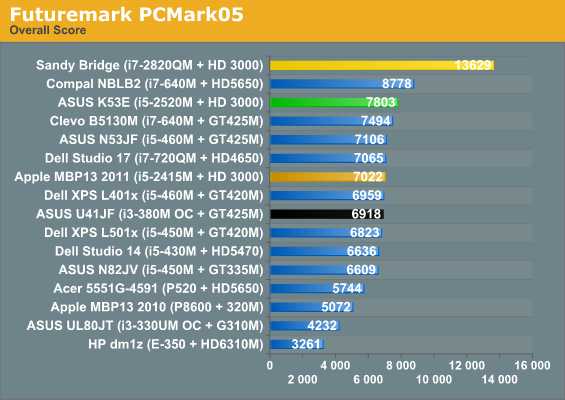
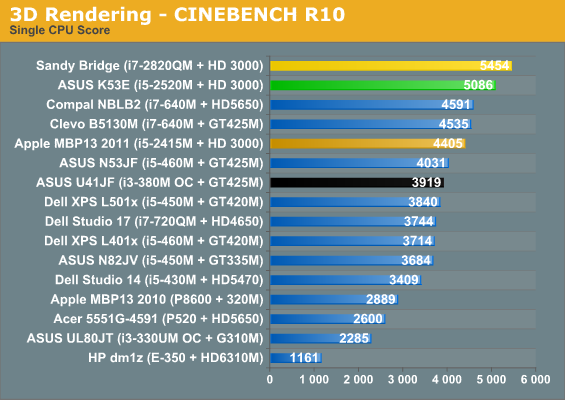
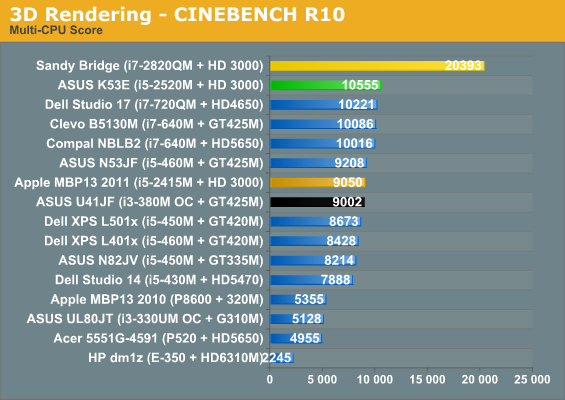
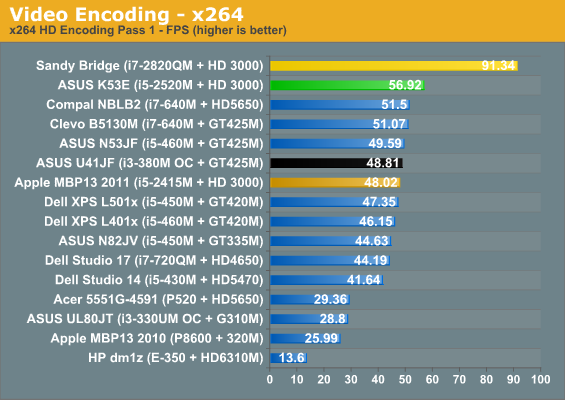

Starting with the new MBP13 comparison, the K53E with i5-2520M comes out an average of 20% faster. Some of that can be attributed to the hard drive differences, as PCMark Vantage shows Apple’s HDD choice is particularly poor, but the CPU intensive tasks are also 15 to 25% faster. It’s interesting that ASUS’ UL41JF happens to put in an overall showing in these applications that matches the MBP13, but that’s in a large part thanks to the 15% overclock. Looking at stock Arrandale CPUs, the i5-2520M turns in slightly higher performance results than the i7-640M, the highest-clocked Arrandale CPU we’ve tested. Even the old i7-720QM in the Dell Studio 17 fails to match the performance of the i5-2520M, which leads by an average of 18% in the above benchmarks (with the only loss coming in Pass 2 of x264 encoding).
Move up to quad-core SNB and an SSD, and of course the dual-core parts look a lot weaker. The i7-2820QM average lead in the above charts is 74%, but part of that is the thanks to the 104% lead in PCMark Vantage. Remove the PCMark results, though, and the 2820QM is still 65% faster than the 2520M. On the other side of the charts—literally—is AMD’s E-350. We know it’s not meant to compete with Sandy Bridge (or even Arrandale or Core 2 Duo), but keep in mind that the cheapest price for such a laptop is going to be around $450. On average, the i5-2520M lays the smack down hard and ends up roughly four times faster than an E-350. Ah, but the E-350 has a much better IGP, right? Well, maybe it’s better, but it’s certainly not faster than Intel’s HD 3000 when it’s bottlenecked by the CPU; here are some 3DMark results before we get to the games to give you an idea of how graphics performance compares.
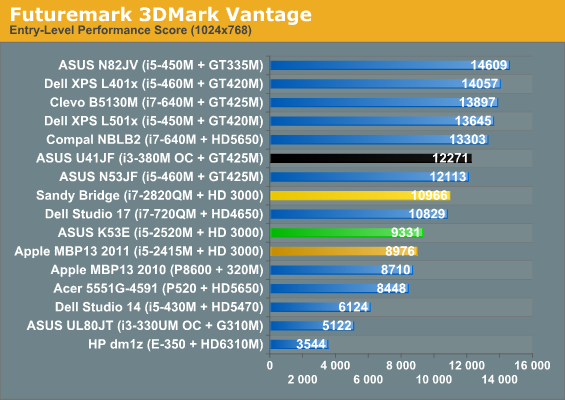
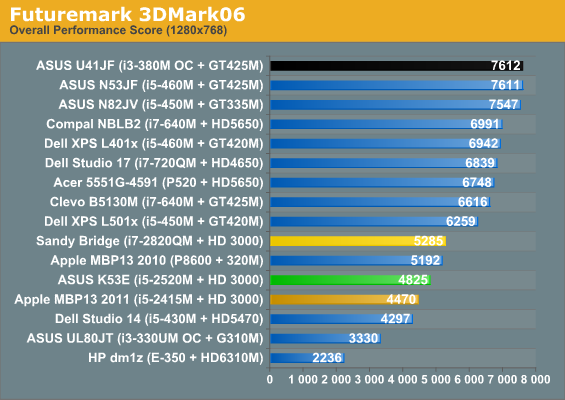
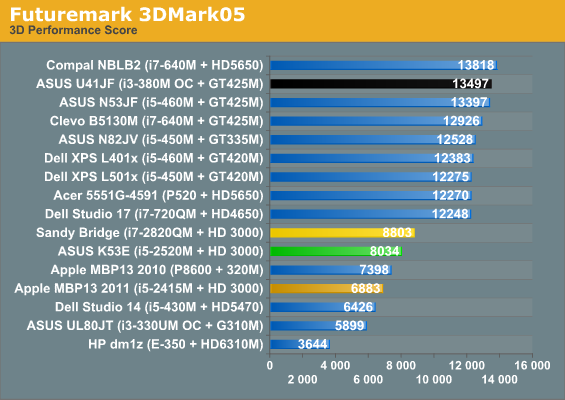
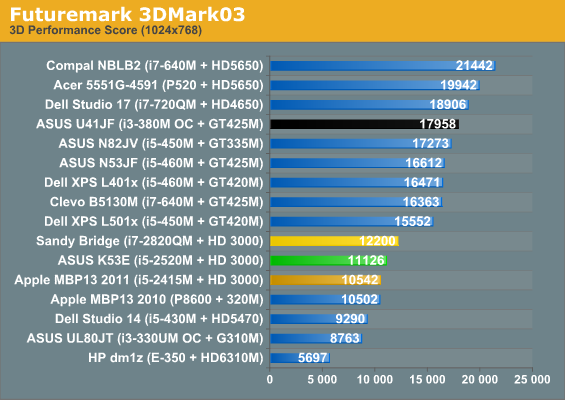
While we would never take 3DMark as the end-all, be-all of graphics performance comparisons, it does give a general idea of what we can expect. The K53E with i5-2520M turns in performance that’s 9% faster than the MBP13 on average across the four versions of 3DMark. That’s actually pretty accurate, as we’ll see in the gaming tests. Likewise, the i7-2820QM results end up being 12% faster than the 2520M, possibly from more aggressive IGP Turbo modes. Again, that matches what we’ll see in the games. On the other hand, even a middling dGPU like the GT 420M/425M still comes out 40-50% ahead of the HD 3000, and AMD’s HD 5650 is 60% faster on average.
What about AMD’s Fusion E-350 platform? If the 3DMark results hold in our actual gaming tests, Intel’s “horrible” HD 3000 IGP offers over twice the performance of the HD 6310M. In fact, even an Arrandale IGP would come within 10% of the E-350 results in 3DMark. It’s not that we love Intel or want them to pummel AMD, and we understand that the E-350 competes in a lower price bracket. Still, many people like to get carried away in discussions of how much better AMD’s graphics are compared to Intel’s IGP. That’s certainly true when you’re looking at discrete GPUs, and compatibility is still better with AMD and NVIDIA drivers, but the latest SNB IGP changed the status quo. HD 3000 works in about 90% of games (roughly estimating), performs well enough to be playable in about 80% of titles, posts scores that are competitive with HD 5470 and GT 320M (and often twice what the current Brazos can achieve), and you get it for free with any 2nd Gen Core i-series CPU. As a friend of mine is fond of saying, it’s hard to compete with “free”.










78 Comments
View All Comments
duploxxx - Friday, April 8, 2011 - link
what a lousy comment:On the other side of the charts—literally—is AMD’s E-350. We know it’s not meant to compete with Sandy Bridge (or even Arrandale or Core 2 Duo), but keep in mind that the cheapest price for such a laptop is going to be around $450. On average, the i5-2520M lays the smack down hard and ends up roughly four times faster than an E-350. Ah, but the E-350 has a much better IGP, right?
you could have also put some higher rated atom's here,Tthey all would have performed even worse for the same price. Its OEM who are pushing this price higher of the Brazos,
Watch the HD3000 scores and how they will be demolished by the LIano A8 series within a month the acer with P520 provides already a good idea about that besides the fact that it will have 4 cores at a much higher turbo frequency. The only thing that will be left is the higher single and dual core turbo mode for intel,.Afterall the i5M is exactly what should be compared with AMD A8M series, not a brazos......
JarredWalton - Friday, April 8, 2011 - link
Exactly, which is why I mention Llano oh... about nine times in the article, and point out that it should double the Brazos IGP performance with a CPU that "is a huge step up in performance from Bobcat." As for Atom: "There’s little (well, nothing really) to recommend an Atom netbook over a Brazos alternative at the $300 to $350 price bracket." Elsewhere I make fun of netbooks (Atom) for being, "slow, often poorly built, slow, too small for many to use comfortably, and above all really slow."The point with the SNB vs. E-350 comparison is that lots of people rip on Intel's graphics as being unfit for just about anything. The reality is that if we take the same mindset, Bobcat is just as bad because the CPU is such a massive bottleneck that it can only muster average graphics performance that's slightly faster than Arrandale. In reality, without the CPU bottleneck (or RAM bandwidth bottleneck) I suspect HD 6310M would be slightly faster than HD 3000. But when SNB offers about twice the graphics performance and four times the CPU performance and 80% of the battery life, yeah, those are items worth mentioning. It's also about 50% more expensive, of course.
A balanced approach is the best for laptops, and that's my complaint with a lot of systems. Sandy Bridge is at least fast enough on the GPU side that the only people who won't be happy are serious gamers--casual gamers can get by. Brazos is also somewhat balanced, but the Bobcat core isn't enough even if it beat Atom--it's less than half the CPU performance of an Athlon II P320 for instance, and you will notice that when installing programs, loading applications, booting Windows, etc. Right now, Brazos needs more CPU, Danube needs more battery life and less power/heat and a better IGP, and gamers need a discrete GPU. Llano could easily take care of all three items.
crazyape995 - Friday, April 8, 2011 - link
I think the point duploxxx might be trying to make is that you intentionally compared Sandy Bridge against the E-350 to make it look bad.I understand the comments about AMD graphics being better than Intel's, but those were directed specifically at the Atom platform.
AMD's E-350 destroys anything Intel's Atom platform can do, even with Nvidia's help. But what sets me off is how you don't hesitate to put it against Intel's flagship processors, but nowhere do I see Atom's results in the benchmarks.
The chart looks like it was devised specifically to make the E-350 look like the worst chip available. And no amount of explainations/disclaimers change that.
JarredWalton - Friday, April 8, 2011 - link
Fact: There are $600+ E-350 laptops available. Regardless of whether or not they should exist, they do exist, and as such it's a fair comparison. I didn't include Atom because it's not even remotely in contention -- and if I had C-50 results I wouldn't include those either. If people don't understand that we selected 12-15 laptops for the charts out of our catalog of over 80+ reviews, I'm not going to apologize. Use Mobile Bench and make your own comparisons.The conclusion talks a lot about the strengths of Brazos and AMD, but some people have a history of being strong AMD advocates in our comments. Every time I/we suggest that AMD might not be the best choice, they have to post a rant about how we're paid off or blind/stupid/[insert pejorative]. Read our Brazos reviews and you'll see we focused a lot of good attention on the platform, though we didn't hesitate to call out the weaknesses.
Simply put, E-350 is not good for current games, and it's not particularly fast in general applications. It's fine for multimedia and basic office work, it gets good battery life, and it doesn't cost a lot. If that's what you want, it's a great solution. Personally, there are too many things I like to do that are sluggish on E-350 (i.e. casual browser games like Bejeweled Blitz come to mind).
derricker - Friday, April 8, 2011 - link
"The conclusion talks a lot about the strengths of Brazos and AMD, but some people have a history of being strong AMD advocates in our comments. Every time I/we suggest that AMD might not be the best choice, they have to post a rant about how we're paid off or blind/stupid/[insert pejorative]. "Has it occurred that it's too obvious in front of everybody's eyes and that you particularly are not doing that great of a job in trying to deny the blatant bias in favor of intel??
The rudeness of your replies comes as a surprise for me here at anand, seeing a heavily biased articled in favor of those who pay the bills, that's yesterday news.
TypeS - Saturday, April 9, 2011 - link
There's no rudeness in his post and it's quite clear the bias towards AMD that you and the other two posters who are attacking Jarred have. Seems Jarred has a point made about AMD fanboys and comments.Learn to be more observant and aware before you make such biased and unfounded accusations. It's OEMs like Sony who are placing Brazos into a regular notebook form factor and pricing it within striking distance of the ASUS notebook. The point that should come across is that if you start looking at some unbalanced (perhaps even overpriced) E-350 options out there, its worth an extra $100 for overall better performance.
There's no Intel bias here. And AMD fanboys need to face reality, AMD has a brief moment in the spotlight with K8 but Intel has been 1 or 2 steps ahead ever since Conroe. Even when comparing appropriate alternatives (based on SKUs), Intel wins.
But you'll find lots of articles where the writers here Anandtech praise AMD, maybe not as much in the CPU market but quite often a lot in the GPU market where they immensely improved and given nVidia a lot of smackdowns that no one expected woujld come.
So take your defensive AMD fanboyism out the door and learn to be more observant and open-minded.
kevlno3 - Saturday, July 30, 2011 - link
To be reality is , don't trust the benchmark. it's not going to benefit you anything. It's only let Intel earn 86% in the market.i trust the benchmark , review . now i suffer in Dell N4110. it's doesn't perform well.
I would said , value of money is most important. when u buy the new notebook , you can save RM3-400 ,why you need to buy Intel? it's wouldn't last you up to 3 years. your model will just out of date in another 9months.
I will go back to AMD after i can let go this Dell N4110.
To be frank to whole world ,80% PC user wouldn't notice the speed different in his work space. you can't notice the speed different in 80% time you turn on your computer , you wouldn't notice the different when u doing autoCAD , sending email , log in facebook . but only thing u notice is when u loading the program. (just because this reason we let Intel earn 80% in market.)
erple2 - Sunday, April 10, 2011 - link
Do you also believe that the Moon Landings were a staged hoax because the Astronauts gave up swearing to things that they were actually at the moon?It's not obvious in my eyes at all. If you want to be rude, go ahead. I think that Jarred (and most of Anandtech) has been quite unbiased towards either camp. Just because your team doesn't win out on every (reasonable) comparison, doesn't imply any kind of bias at all.
ET - Saturday, April 9, 2011 - link
Jarred, I agree with your reasoning for including the E-350. Some people are blinded by AMD fanboyism, it seems. I have a preference for AMD, but I think your comments are right on the money. I bought a Thinkpad X120e because I think that AMD did a great job reinvigorating the small form factor. At 15.6" the E-350 has more competition and the premium for Intel based solutions is lower, so I think it's a good idea to give buyers an idea of how it compares in this form factor.That said, I think it would have been interesting to see how the i3-2310M version of this laptop compares.
kevlno3 - Saturday, July 30, 2011 - link
i would tell u , u wouldn't notice you are using E350 or core i3 2310. i totally dislike my Dell N4110 core i3 2310 . because the battery life is just 3hours .(normal price is RM1899 from Dell website , i buy promotion price from dealer , RM1.6k with HD6630 , 4GB , 500GB 7200rpm) E350 is about 6 hours & price is just RM1099. of course i wouldnt go for that model , because i need to play game , i need some model at least with HD6470.in fact currently Llano notebook is going crazy . pair with 6650 but only help the benchmark about 10% & the price is nearly to the core i5 model. core i5 2410 + GT540 RM2299. Llano sell RM 1800.
Dell i5 2410 + HD6470 is selling RM1899.
i would agree the price if AMD Llano w.o the HD6650 & the price is selling RM1.4k with 5-6 hours battery life
USD 1 = RM3
in fact i using C50 to complete all my office work with 8hours battery life . but i think i can't do it with Atom. if not why most of my friend sell it after 2 week?